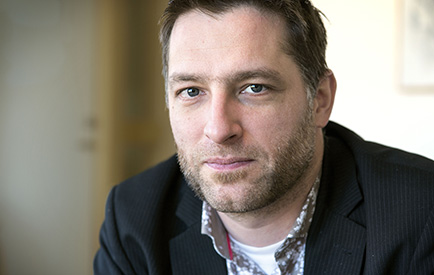"Don't be afraid to simplify"
How the researcher becomes a better communicator

Why must researchers communicate what they are doing, isn't publishing articles in scientific journals enough? And social media – are they really relevant to a researcher? Asking Wouter van der Wijngaart, successful research is the one that reaches out. His advice is: "Don't be afraid to simplify".
Lack of time. This is the most common excuse from researchers for not communicating with the public. Since communication isn't an academic merit, this has low priority. But many are clueless about how to reach out with their results.
Someone who really thinks this is important, is Wouter van der Wijngaart, Professor of micro and nanosystems. At KTH he is known not only for his research on tiny things, but for his passionate commitment to communication issues and how to market research.

"Why a researcher needs to communicate? It's all about spreading your ideas so that others can benefit from them - other researchers or companies. It's also important for the public to have access to research results", says Wouter.
“Without broad communication, only peers in your own small research field will find your work. People or organisations that could benefit of your results may miss their existence.”
Showcasing what you do is also about building KTH's brand, being a university that people hear about. Eventually, this will have an impact on the school's ranking. And as a researcher at KTH, you are obliged to show what the taxpayers get for their money. Research funders also want grant recipientsto market their work. But communication is, above all, about getting citations.
And the key in all communication is to explain why your research is important, Wouter says.
"You should be able to give a few concrete examples of what your research can be used for, otherwise it's not interesting. A doctoral student spends five of the best years of her life in a lab or behind a computer. If that person can't explain why, she should ask herself why she’s doing this", he says.
Explaining the impact of research is about communicating how your results improve peoples’ lives or has the potential to solve a problem.
"Sometimes, it may be difficult to explain the impact of research showing how stars move, but KTH does mostly applied research."
But how do you reach out? According to Wouter, social media is an effective channel to market research, and at the same time a way to keep track of what is happening.
"As research becomes increasingly multidisciplinary, it is easy to lose track of what is happening, it's impossible to keep up. But Facebook is very smooth. By following, among others, Science and Nature's posts, I keep to some extent track of what happens in research. Perhaps one out of five posts interests me, but without these I would have missed those pieces of news. "
When someone in Wouter's group publishes an article, a piece of communication machinery starts in the department. Someone adds information on Wikipedia. Then they check with GVS' communications department to see if they want to do a story on it or not.
"Often the school communicators are more interested," he says.
After that, we write a "mini-abstract" in which the "what and why" of our findings are explained in 3-5 sentences.
"These sentences are very useful for various posts on social media. Don't be afraid to simplify the message. The question to answer is: "Who cares?" Afterwards, I often feel that these sentences turned out so well that they should have been in the manuscript’s abstract."
One specifically useful channel is LinkedIn. Wouter is a member of several industry forums and groups related to his field of research.
"Often, these groups already have many followers. If you post something there, you may have 15,000 people getting access to your research. Suddenly you reach 10,000 more than you would have at a regular conference!"
All in all, there are many reasons to spend some time marketing the research.
"I also put some of my lecture material on my Youtube channel and often get comments like 'thank you, now I finally understand' from people all over the world. It feels nice to be a global teacher."
Text: Anna Gullers
